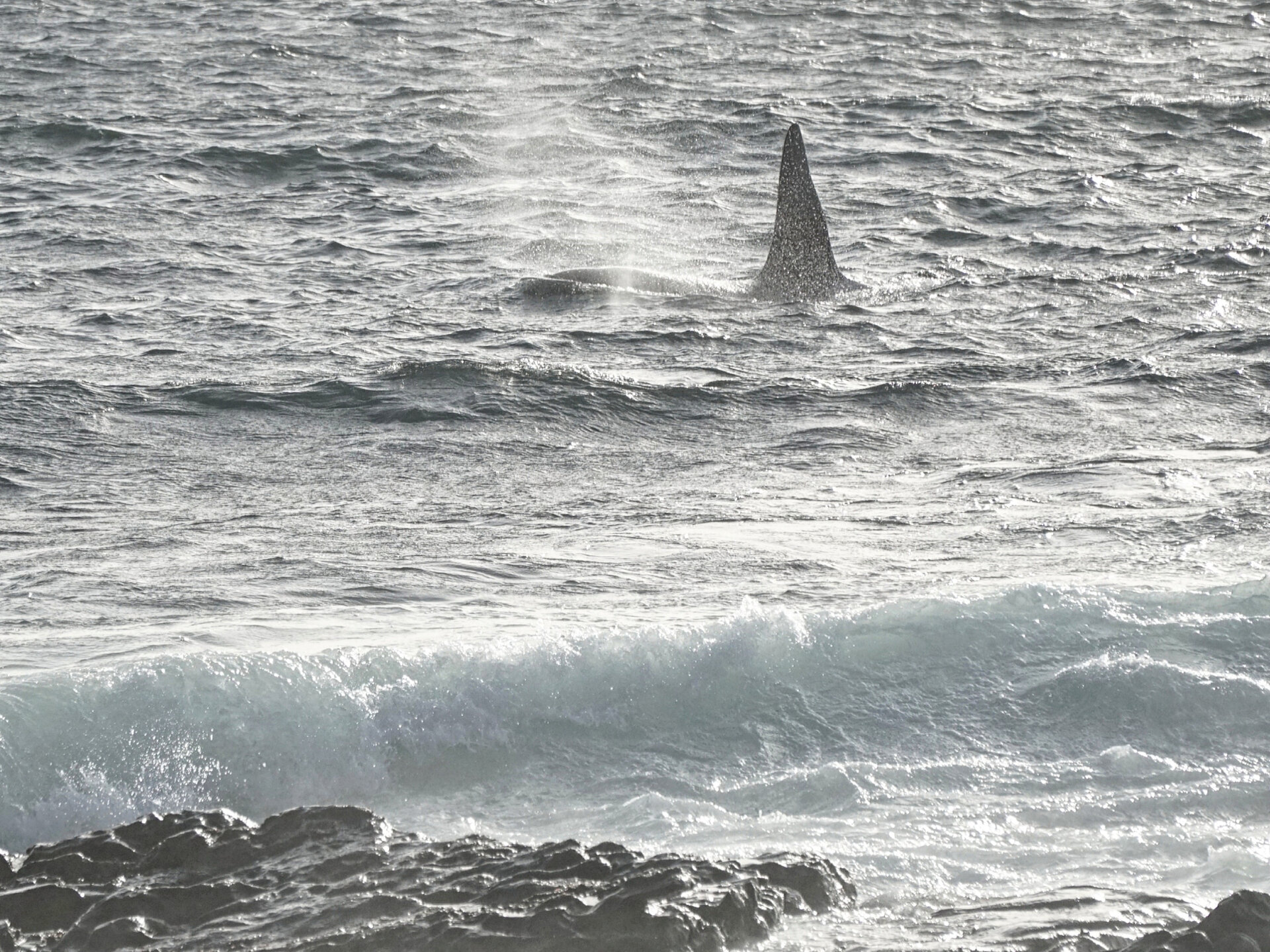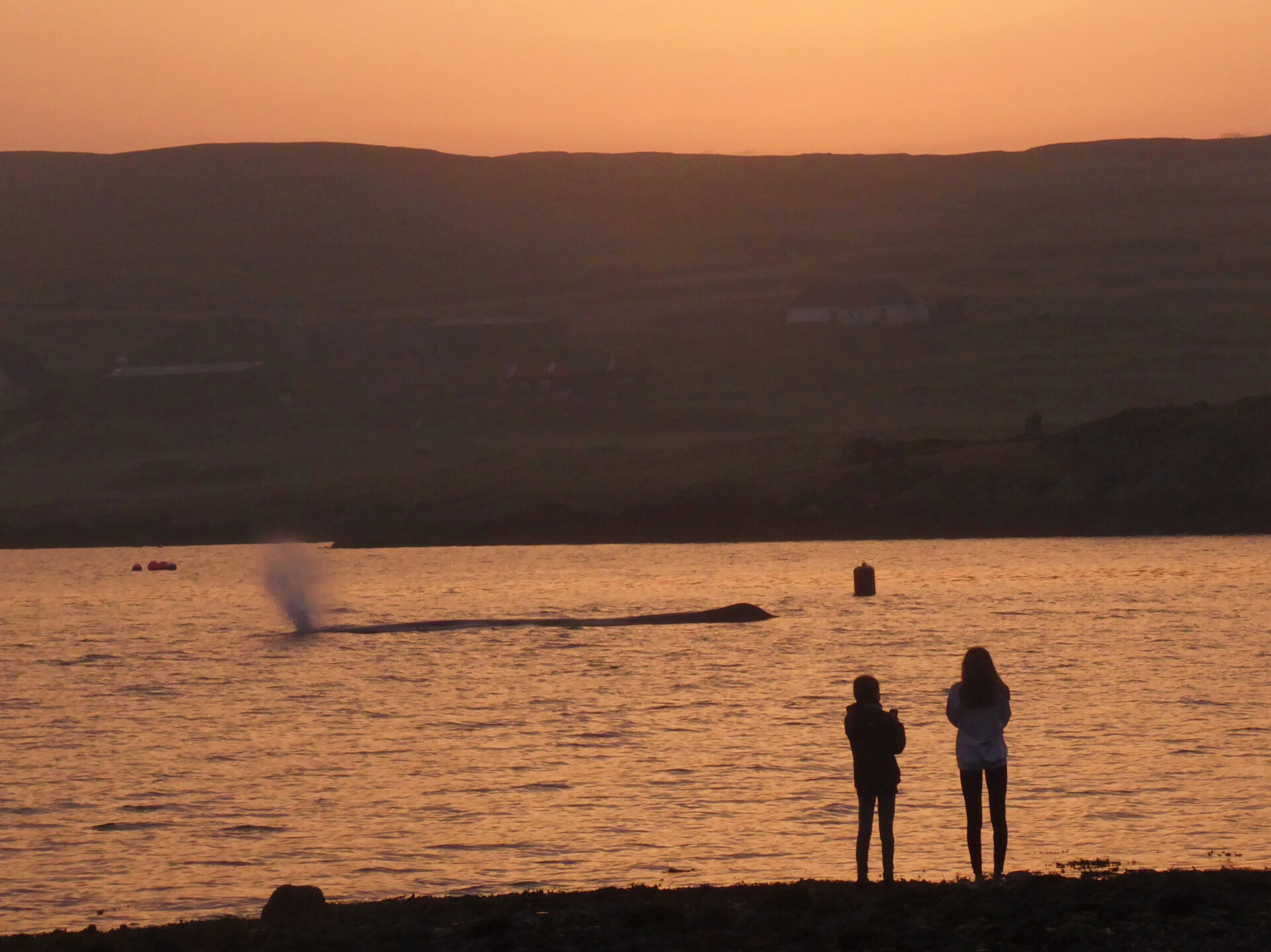I was just settling down to work when my phone beeped an alert, ‘Orca heading south from Lerwick’. For a moment I thought about approaching deadlines and unanswered emails, all the things I should be doing, before grabbing my camera and heading to the beach.
Since joining the ‘Shetland Orca Sightings’ Facebook page the opportunity of spotting the incredible creatures has become one of Catherine Munro's greatest pleasures. And a distraction from work. Read her post to discover more about the islands' whale watching community.
As I walked down the narrow path, clouds hung heavy, darkening the wintry day. A steel grey sea carried fast-moving white horses, their bright bodies lit by invisible sun. I scanned the water, looking for signs of movement, worrying I was too late, that I had missed them. Suddenly, a huge fin rose from the water, and I realised there was a bull orca just a few feet away from me.
I heard him breathe, spray meeting spindrift and smirr, carried with the wind, merging with the air around me. Momentarily joining our worlds. He moved towards me, another breath, before descending into the depth.
A few seconds later he resurfaced, joined by three more whales. One was young, moving in unison alongside their mother. They circled the bay, surfacing regularly, before turning and heading out to sea.
Marine conservation
The people gathered by the shore talked excitedly, discussing where the whales were next likely to be seen. Then they got in their cars to follow them south. Continuing the adventure. That day, I couldn’t join them, instead I went back home to work, grateful for the unexpected magic in my day.
Soon the orca sightings Facebook page filled with the day’s photographs, their detail allowing the pod to be identified as the 27’s. Named after Vaila the matriarch’s identification number in the Scottish Killer Whale ID catalogue, this pod is regularly spotted in waters around Shetland. With changes to technology and communication, their movements, habits, and interactions have become a familiar part of island experiences. This knowledge is forging new relationships, between islanders and the sea and connecting them to global marine conservation.
Individual orca have distinctive features, the shape of their fin or scars on their saddle patch, that allow them to be identified. Footage from cameras and drones is now in such high resolution that such details can be clearly seen.
Hugh Harrop, a local wildlife expert, explained that knowing individual animals and observing them over time provides information on the interactions between pod members; travel and hunting behaviour; gestation periods and longevity. All this information helps create a picture of these animal’s lives.
Hugh was an integral part of compiling this data into the Scottish Killer Whale ID catalogue. This catalogue documents the whales known to spend time in Scottish waters, which is a valuable resource people and organizations who work with the marine environment.
Knowledge gained from years of careful observation regularly provides new insights into whales’ behaviour and the interactions between predators and prey in our waters.
Nick McCaffrey uses his skills as a drone pilot to record whales around Shetland. He explained, “Drones can show you something completely different, you can look down and see what they are actually doing in the water.
“When you see how humpback whales move their pectoral fins it looks like they are flying. They seem to do things just for the fun of it. You will see them do a complete roll and pirouette, things that you just can’t see from the shore.
“Drones have enabled me to share this, to show how beautiful and complex their behaviour can be. I hope that sharing these insights will kindle people’s enthusiasm for the environment. We are only just scratching the surface of what drones can do and the more we get out and use them, the more we start to get these pieces of the puzzle.”
Moments captured by drone can start to give clues about the reasons for animals’ behaviour and Nick’s work regularly gets used in academic articles. For example, recent footage he took indicated that pilot whale pods might come to inshore waters for calves to be born. This is now being explored further by marine scientists and could lead to new discoveries about this species’ lives and habits.
When you see how humpback whales move their pectoral fins it looks like they are flying.
Hugh and Nick are both contributors to a long-term study based at University of St Andrews. The ECOpredS Project (Ecological Consequences of Orca Predation on Seals) seeks to learn more about the complex relationships between these two marine mammal species, with the aim of using this information to better protect both.
Observations from wildlife experts provides a substantial amount of data to this research but they are also appealing for information from the public who encounter orca.
In 2016 the ‘Shetland Orca Sightings’ Facebook page was established and currently has almost 36,000 members. This page allows sightings of cetaceans around Shetland’s coastline to be shared immediately. Once a sighting is reported, users comment on a pod’s current location and direction of travel. This information gives people the chance to see these amazing animals.
Hugh described how these opportunities can lead to “familiarity, affection, care and consideration”.
“The Facebook page means that everybody can contribute to science and help researchers. Photos taken by the public can show new scars on individuals and tell us about pods’ movements and behaviours. Everybody can be part of making history.”
The possibility of seeing whales has become one of my favourite things about living in Shetland. I am signed up to alerts from the orca sightings page and whenever I am driving and notice parked cars and people looking out to sea, I always stop for a look. I love the excitement that comes from being part of a community of enthusiasts. The joy of these days is made even more special by the knowledge that these encounters are directly contributing to work that helps conserve these beautiful creatures.


